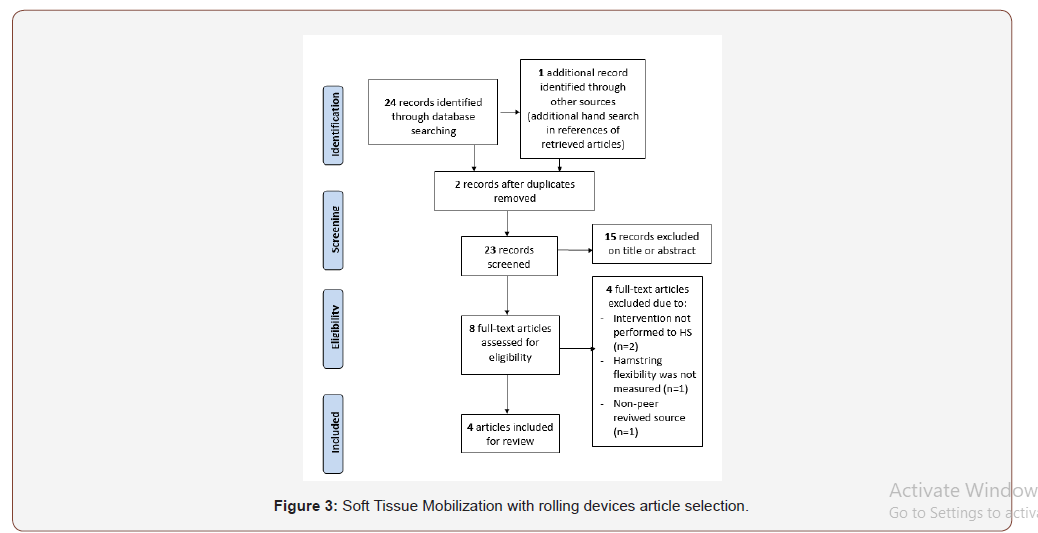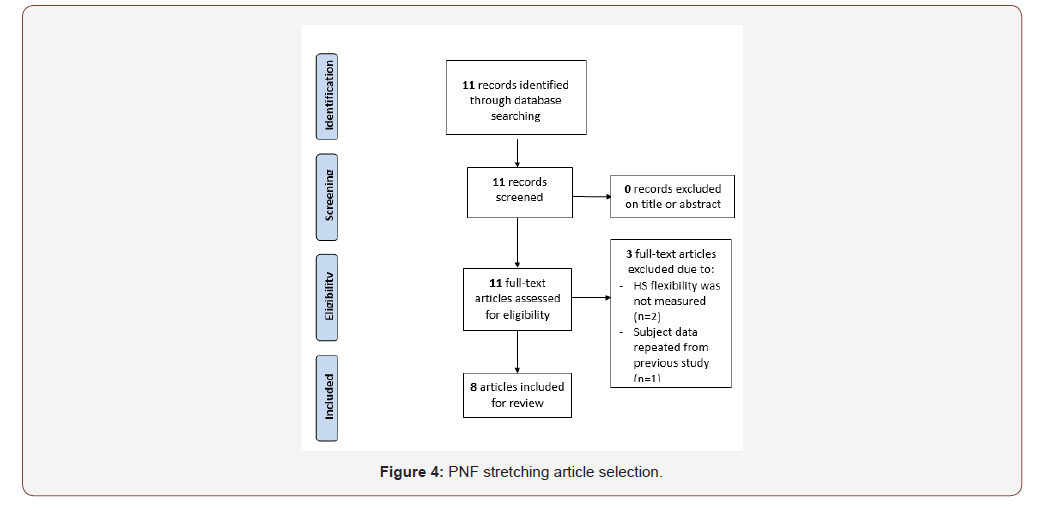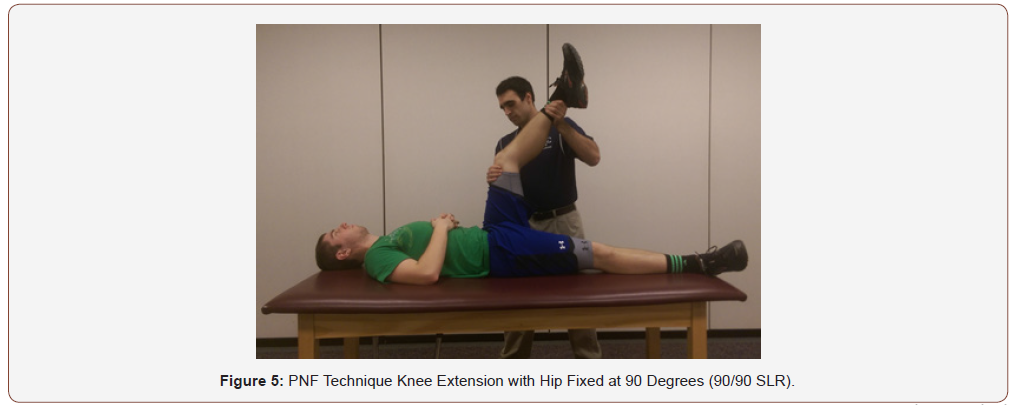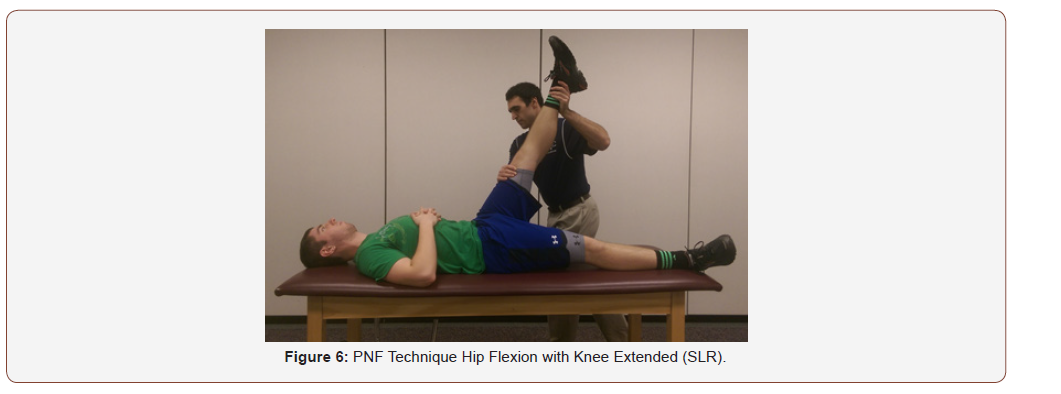 Research Article
Research Article
Effectiveness of Soft Tissue Mobilization with Rolling Devices Versus Proprioceptive Neuromuscular Facilitation Stretching for Increasing Hamstring Muscle Flexibility in College-Aged Athletic Population
Derek Longenecker1 and Michael L Fink2*
1Department of physical therapy, Lebanon Valley College Physical Therapy Program, USA
2Co-chair and Associate Professor of Physical Therapy, Lebanon Valley College, USA
Michael L Fink, Department of physical therapy, Lebanon Valley College, USA
Received Date: March 04, 2020; Published Date: March 13, 2020
Abstract
Background and purpose: Foam rolling is a commonly used technique for increasing soft tissue extensibility especially after injury, but little research exists to showcase its effectiveness to date. The purpose of this article was to assess the effect of soft tissue mobilization with roller devices compared to PNF stretching on hamstring muscle flexibility.
Methods: A literature search of Medline and Cinahl Plus was conducted to identify potential studies (published through October 2014).
Findings: 12 articles met inclusion criteria (4 related to soft tissue mobilization with roller devices, 8 related to PNF stretching). No studies provided a direct comparison of soft tissue mobilization with roller devices and PNF stretching. All 8 studies related to PNF stretching report significant improvement in hamstring flexibility following intervention. 3 of 4 studies related to soft tissue mobilization with roller devices reported hamstring flexibility improvement.
Clinical relevance: Soft tissue mobilization with roller devices and PNF stretching are both common techniques in physical therapy practice. Physical therapists should be familiar with expected outcomes and supporting evidence regarding these interventions as many patients require improved flexibility.
Keywords: Stretching; Foam roller; Range of motion; Massage; Muscle tightness
Introduction
Using rolling devices for soft tissue mobilization, often termed “muscle massage” or “myofascial release”, is prevalent in modern athletic training, personal fitness and physical therapy practice. Athletes, patients, and those interested in maintaining fitness alike are delivered claims about the potential benefits of these devices. Claims range from decreasing fatigue post-exercise to improving athletic performance to increasing range of motion (ROM) and muscle flexibility [1]. This may be of special interest to physical therapists because ROM and flexibility limitations are common patient/client impairments that often must be addressed to restore function. However, the majority of device manufacturers promote these products without sufficient, or often any, research to back up their declarations. As a result, it is important to appraise the available literature to determine the effectiveness of rolling devices in restoring muscle flexibility and ROM. It is also logical to compare these effects with proprioceptive neuromuscular facilitation (PNF) stretching, another commonly used technique aimed at improving flexibility/ROM [2].


Foam rollers (Figure 1) and rolling pin type devices such as “The Stick” [3] (Figure 2) are commonly advertised tools. Foam rollers are often referred to as self-myofascial release devices, due to use of an individual’s own body weight rolling over the foam roll to apply pressure onto muscle and fascial tissues1. Rolling pin type devices use a non-motorized solid spindles, capable of producing direct force to muscle externally, using a rotary movement pattern. Both rolling devices may be fixed onto an external apparatus to allow for a self-soft tissue mobilization effect [4], can be self-applied, or can applied by another individual externally.
PNF stretching, specifically contract-relax stretching, involves a therapist passively moving a muscle group to the point of resistance due to restriction then asking the client to provide a volitional isometric contraction of either the same muscle being stretched or the antagonist muscle(s). The volitional isometric contraction is followed by relaxation of the muscle group and passive progressive stretching to a new point of restriction5. Contract-relax PNF stretching, is based on the concept of reciprocal inhibition and autogenic inhibition. Reciprocal inhibition describes the phenomenon of activation of a muscle group causes inhibition of the antagonist muscle group. It is believed that the isometric contraction causes input to the Ia-inhibitory interneurons, which cause inhibition of the motor neurons to the antagonist muscle group [5]. When applying this concept to the hamstring muscle group, the quadriceps are isometrically contracted resulting in a reflexive relaxation of the hamstring muscle group. In contrast, autogenic inhibition applies to contraction of the muscle group being stretched which activates Golgi tendon organs, causing inhibition of motor neurons of the same muscle through IBMinhibitory interneurons [5]. When autogenic inhibition is applied to the hamstring muscle group, the hamstrings are isometrically contracted resulting in a reflexive relaxation of this muscle group.
The purpose of this study was to compare soft tissue mobilization with rolling devices to that of PNF stretching for increasing hamstring muscle flexibility in college-aged athletic population to determine the most effective intervention for clinical use.
The hamstring muscle group was chosen to evaluate the efficacy of rolling devices versus PNF for restoring muscle flexibility due to it being a site of frequent muscular tightness. Additionally, hamstring tightness can have a negative effect on performance and place the athletic population at higher risk of injury. Yasuhiro et al [6]. concluded that hamstring tightness decreased medial and lateral reach on the star excursion balance test. The test scores support decreased performance and also support increased future injury risk [6]. Hamstring muscle tightness can even contribute to low back pain by limiting rotation of the pelvis during flexion. Movements with large amounts of full body flexion, in the presence of hamstring tightness, puts greater stress on posterior chain structures supporting the spine Zhu Q [7]. further described a correlation between adolescents with hamstring tightness and MRI findings of disc herniation in the lumbar spine and lumbo-sacral junction [7]. These potential outcomes associated with hamstring inflexibility place even more importance on determining an effective means of improving or restoring hamstring muscle flexibility.
Methods
Search
A literature search of Medline and Cinahl Plus was conducted between September and October 2014 to identify articles related to hamstring muscle flexibility using soft tissue mobilization with rolling devices and PNF stretching. The search terms for soft tissue mobilization with rolling devices included: “Self-myofascial release”, or “foam roller”, or “The Stick”, “range of motion” or “flexibility”, and “muscle”. The search terms for hamstring PNF stretching included: “PNF stretch”, “PNF stretching”, “hamstring”, and “range of motion”. The following limitations were implemented: peer-reviewed, research article (Cinahl Plus); English (Medline and Cinahl); humans (Medline); publication date 2000-present.
Inclusion criteria
Peer reviewed articles, written in English, from 2000 to present, with the aforementioned search terms for each conditions were included. Additionally, research studies must discuss an intervention fitting the above operational definition of soft tissue mobilization with rolling devices or PNF, target the hamstrings, measure hamstring flexibility, and include a sample of subjects with a mean within college-aged range (18-26).
Exclusion criteria
The articles were excluded if the intervention did not fit into either the operational definition for soft tissue massage with rolling devices or PNF, if the intervention did not target the hamstring muscle group, the subjects were not college-aged (18-26), or hamstring flexibility was not assessed in some manner.
Findings


The search of CINAHL PLUS and MEDLINE identified 24 articles (+1 from a hand search) related to soft tissue mobilization with rolling devices and 11 articles related to PNF stretching. Of these articles 8 articles about soft tissue mobilization with rolling devices and 11 articles pertaining to PNF were retrieved for further evaluation. After further review 4 articles based on soft tissue mobilization with rolling devices (Figure 3) and 8 articles focused on PNF (Figure 4) satisfied the inclusion criteria and were included in the review. No studies provided a direct comparison of soft tissue mobilization with roller devices and PNF stretching.
Soft Tissue Mobilization with Rolling Devices
Three of 4 studies related to soft tissue mobilization with roller devices reported hamstring flexibility improvement, however each study was conducted with differing patient positioning and treatment parameters (Table 1).
Table 1:Literature summarizing statistical evidence for soft tissue massage with rolling devices.

Proprioceptive Neuromuscular Facilitation
In regard to performance of proprioceptive neuromuscular facilitation, a variety of techniques are included under this umbrella term. The majority of the following studies used a holdrelax stretch or modified hold-relax stretch technique. The holdrelax technique traditionally involves an isometric contraction of antagonist muscle followed by relaxation [8]. A modified hold-relax differs by selectively neglecting a direction of stretch or contraction during the technique (ie. Stretch or contraction performed without hip rotation) [9]. All 8 studies related to PNF stretching report significant improvement in hamstring flexibility following intervention (Table 2).
Table 2:Literature summarizing statistical evidence for PNF stretching.

Discussion
More literature exists investigating the effect of PNF stretching on hamstring flexibility than soft tissue mobilization with roller devices. Additionally, 3 studies assessing PNF stretching were randomized controlled trials. Comparatively, only 1 study assessing soft tissue mobilization with roller devices was a randomized controlled trial. Also using the Philadelphia Panel Score, 3 studies assessing PNF stretching scored at the highest recommendation of intervention (A grade), with no studies scoring the lowest recommendation of intervention, a C grade. Conversely, no study examining soft tissue mobilization with rolling devices scored an A grade and 1 study scored a C grade.
It is important to point out the differences in how hamstring flexibility was measured throughout the studies. It is possible that inconsistencies in measurement of hamstring flexibility may be a factor for the varying amounts of improvement determined. The studies assessing the effect of PNF stretching on hamstring flexibility demonstrated more consistency with measurement. Four of 8 studies used active knee extension angle 1 out of 8 passive knee extension angle, and 3 out of 8 used hip flexion PROM. The studies assessing the effect of soft tissue mobilization with roller devices on hamstring flexibility varied largely on their measurements. In fact, no 2 studies measured hamstring flexibility in the same manner. One of 4 measured standing hip flexion AROM and PROM, one measured supine hip flexion AROM, one measured supine hip PROM, and one measured sit and reach. Additionally, the hamstring muscle crosses both the hip joint and knee joint. As a result, the majority of studies made note of stabilization of the joint they were not assessing in order to view a more accurate change in muscle flexibility. Lastly, the sit and reach test may be difficult to compare directly to the other means of measuring hamstring flexibility. The sit and reach test does not only assess hamstring flexibility, but also allows for lumbar spine mobility, thoracic spine mobility, and even shoulder flexion to factor into the measurement.


In addition to a variety of measurements used to gather data, parameters also differed among the general intervention groups. PNF stretching interventions differed on the joint used to primarily generate stretch (knee in Figure 5) (hip in Figure 6), duration of stretch (range= 7- 15 seconds), duration of contraction (6-30 seconds), number of repetitions (1-5 reps), and general type of PNF stretch used (Hold-relax stretch, Contract-relax stretch, Slow reversal hold-relax, or modified). Despite the variations above, all PNF stretching studies demonstrated pre to post intervention improvement of hamstring muscle flexibility. PNF stretching may present significant clinical application by allowing a wider range of autonomous decision-making regarding parameters and still accomplish the goal of improving hamstring flexibility. Soft tissue mobilization with roller devices demonstrated even greater parameter variability including: differences in device (length, circumference, and density), rate (self-paced versus rhythmically constant at 60-120 beats per minute), pressure (self-determined by body weight versus fixed at 13 kg of pressure), duration of technique (ranging from 5 seconds to 3 repetitions of 60 seconds), application of device (self-application on ground, hand held selfapplication, or fixed via external apparatus). In contrast to PNF stretching, significant improvement in hamstring flexibility was not demonstrated in all studies assessing the effect of soft tissue mobilization with roller devices. However, it is important to note some significant effect was seen in all studies examining the effects of foam rolling on hamstring flexibility. As a result, further study should be done to determine the most effective parameters for increasing hamstring flexibility with roller devices.
Another difference between studies existed within their inclusion of participants. Many studies in both intervention groups were completed with small sample sizes. Overall, more studies were conducted examining PNF stretching and 6 of the 8 included 30 or more participants. Only 2 of the 4 studies examining soft tissue mobilization with roller devices had 30 or more participants. However, in 5 of the 8 PNF studies the participants were exclusively male compared to only 1 of 4 studies examining roller devices. Additionally, participants from 4 studies [2,9-11] were included on the basis of demonstrating limited hamstring flexibility measured by active knee extension angle of greater than 20 degrees from full terminal knee extension. The remaining 8 studies (including all of the studies examining soft tissue mobilization with roller devices) primarily included participants presenting without any form of significant lower extremity injury in a determined time period predating the study. It is possible that participants with established hamstring flexibility limitations prior to the study may demonstrate greater improvement following an intervention aimed at restoring hamstring flexibility. In contrast, generally healthy individuals, who already demonstrate normal hamstring flexibility may be less likely to demonstrate significant further improvements.
The majority of studies assessed acute effects on hamstring flexibility following interventions. Spernoga [9] determined that improved hamstring flexibility due to PNF stretching was maintained for 6 minutes following a technique. Melam [12] examined the long-term effects of PNF stretching on hamstring flexibility. Hamstring flexibility was improved in both the therapist applied PNF and self-applied PNF 6 weeklong stretching programs. As a result, PNF may allow for clinical application by immediately improving hamstring flexibility, providing lasting changes in flexibility following an episode of physical therapy, or providing a home exercise program that will foster improved hamstring flexibility in the long-term. The majority of studies assessing the effect of soft tissue mobilization with roller devices on hamstring flexibility also did so acutely. However, Macdonald et al.1 assessed effects for 3 days following a 60 second session of self-myofascial release using a foam roller device following an intense bout of exercise. Significant improvements were noted at 24 hours post intervention for AROM and 48 hours post intervention for PROM compared to the control group. Soft tissue mobilization with roller devices after an intense bout of exercise may be effective up to 2 days following intervention, which may be of benefit to higher functioning patients or athletes capable of performing strenuous exercise with limited hamstring flexibility.
Timing of interventions is another notable area of difference between studies. The majority of interventions were performed following some form of 5 minute warming up activity and then a measurement was taken. Wenos [13] examined a variety of cardiovascular and modality methods of warm up and determined cardiovascular activity achieving a respiratory exchange rate of 1.00 was most effective. Trampas [11] reported improved benefit when PNF was preceded by myofascial trigger point release. As a result, PNF appears to be most successful following warm up or soft tissue techniques through manual therapy. Mohr [14] determined a more significant improvement in hamstring flexibility when foam rolling was followed by static stretching. As a result, soft tissue mobilization with roller devices may have a greater effect when preceding another form of stretching. Techniques with roller devices may act as a warmup to enhance the effects of other stretching techniques or potentially the combination of multiple techniques addressing muscle flexibility may create a summative effect. As a result, it appears logical for future studies to examine the effects of soft tissue mobilization with roller devices followed by PNF stretching to improve hamstring muscle flexibility.
Lastly, it may be important to examine a broader comparison of PNF stretching and soft tissue mobilization with rolling devices on the hamstring muscle group. Anecdotally, a percentage of individuals report discomfort performing foam rolling for the first time. Additionally, Macdonald et al. [1] reported pain experienced from foam rolling decreased over a 24-48-hour period except for the posterior thigh region. Comparatively, PNF stretching commonly involves passively moving a participant’s lower limb to the point of discomfort. In addition, to tolerance of intervention other factors can contribute to the overall benefit of each intervention. It is postulated that PNF stretching can decrease muscle force production and increase latency of muscle activation post intervention. These outcomes may create a situation of decreased performance and increased injury risk for an athlete. Macdonald et al. [1] reported no significant differences in maximal voluntary contraction force at 24, 48, and 72 hours post 60 second session of foam rolling compared to control group. As a result, future studies should compare PNF stretching and soft tissue mobilization with roller devices based on pain experienced by participant during intervention, effect on force production following intervention, latency of muscle activity following intervention, and effect on muscle flexibility.
Conclusion
Both PNF stretching and roller devices are commonly used in outpatient physical therapy practice. The impact of PNF stretching on hamstring flexibility was well supported by the literature. Variations in technique, stretch duration, contraction duration, repetitions, and application from therapist or self-application all yield increases in hamstring flexibility either immediately or long term. Conversely, at this time few randomized controlled trials have been completed regarding the effect of soft tissue mobilization with roller devices on hamstring flexibility. Soft tissue mobilization with roller devices was most supported in studies using a foam roller device over the hamstring region. As a result, more randomized controlled studies should be performed assessing the effect of soft tissue mobilization with roller devices on the hamstrings, specifically with foam rollers. Additionally, no study directly compared PNF stretching to soft tissue mobilization with roller devices. It is possible that each intervention may affect the hamstring more broadly than just muscle flexibility. As a result, future studies should compare PNF stretching and soft tissue mobilization with roller devices based on pain experienced by participant during intervention, effect on force production following intervention, latency of muscle activity following intervention, and effect on muscle flexibility [15-18].
Acknowledgment
None.
Statement of Financial Disclosure and Conflict of Interest
“I affirm that I have no financial affiliation (including research funding) or involvement with any commercial organization that has a direct financial interest in any matter included in this manuscript, except as disclosed in an attachment and cited in the manuscript. Any other conflict of interest (i.e., personal associations or involvement as a director, officer, or expert witness) is also disclosed in an attachment.”
-
Derek Longenecker, Michael L Fink. Effectiveness of Soft Tissue Mobilization with Rolling Devices Versus Proprioceptive Neuromuscular Facilitation Stretching for Increasing Hamstring Muscle Flexibility in College-Aged Athletic Population. W J Yoga Phys Ther & Rehabil 2(3): 2020. WJYPR.MS.ID.000537.
-
Effectiveness, Stretching, Foam roller, Range of motion, Massage, Muscle tightness, Physical therapists, Athletes
-

This work is licensed under a Creative Commons Attribution-NonCommercial 4.0 International License.






